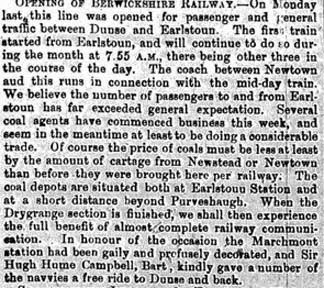One such event in Earlston involved John Thomson, a coal agent. On 7th February, 1866, aged just 36, he died as a result of injuries to his arm being crushed betweenthe buffers and coal trucks at Earlston Station. A newspaper report in ‘The Kelso Chronicle’ of Friday 9th February, 1866, gave the full details:
“John Thomson, who got his arm broken and severely bruised between the buffers two wagons on Monday last week, died from the effects of the accident about one o'clock on Wednesday morning. Thomson having been sergeant in the Earlston Volunteer Company, the members the Corps, who were greatly interested in his case, and who in the beginning of the week thought it was assuming very serious aspect, subscribed to procure the services of a surgeon of eminence from Edinburgh, and in this they were liberally assisted by the public in general.
Accordingly, on Tuesday morning, Mr Andrew Murdison, a brother volunteer of Thomson’s, very kindly took the trouble of going personally to Edinburgh, in addition to sending a telegram (which, as is too common, landed at its destination long after the sender had been conveyed by train thereto) to seek the services of Dr. Annandale, to whom he had been recommended by Dr. Riddell. [The local physician]
This
gentleman accompanied Mr Murdison back to Earlstoun in the afternoon, and
having seen and examined Thomson, deemed amputation of the arm necessary. This
operation Dr Annandale performed about 4 o’clock in the afternoon but Thomson
gradually sank, and about nine hours thereafter expired.
Thomson,
who was a young unmarried man in the prime of life, was much respected in the
place, and his premature death under such circumstances has excited deep
sympathy for those of his family who survive him.”

Two trains in Earlston station
Copyright © A R Edwards and Son, Selkirk. (Cathy Chick Collection). All Rights Reserved
************
Background Notes:
- · John
Thomson’s Family
John was born Earlston, 2nd May 1829, the fourth son, in a family of eight, children of William Thomson and Janet Slight/Sleigh, the great, great great, grandparents of Auld Earlston member Sheila McKay.
In the 1851 census, William, born in Lauder, was described as a thatcher, with the family living on Main Street, Earlston. John’s occupation was given as a sawyer.
Father, William died in 1860, with John named as the informant, on the death certificate.Where John was at the time of the 1861 census remains a mystery, as he was not in Earlston. Could he possibly be the John Thomson, born in Earlston , aged 30, serving as a police constable in Chirnside? Impossible to say when his name is so popular in the region. The Heritage Hub in Hawick holds a substantial collection of police records, but the Constabulary Records for Berwickshire did not begin until after 1866.
By the time of his death, John had had a change of occupation to that of coal agent. Coal represented the single largest freight traffic on the railways. John would have been working in the coal merchant’s yard at the station. As the coal wagons arrived from the Dalkeith coalfields, his role involved liaising with the local coal merchants on the purchase of the coal.
- ·
Medicine in 1866
John was tended to initially by the local physician Dr. Riddell, and we have a fine description of the doctor in the writings on Earlston people and places by Rev. William Crockett.
"Here was a man skilled in diagnosis, a very capable servant,
responsive to every phase of human distress. Even if (because of his slightly
humped back), they spoke of him as”Humpy" Riddell, it was never with
any feeling of disrespect. The doctor was endowed with a big brain; poor
people said he had a heart of gold. He showed his queer habits on occasions
- a street fight fascinated him for instance. Dr Riddell
believed in prayer and once told the minister "I always pray before I
start an operation."
This was a time of
early days in the use of anaesthesia, with infection control weak, and the
incidence of mortality following amputation high. It was only in 1867 that
Joseph Lister published his work in using carboiic acid as an antiseptic.
- · Earlston’s
Community Spirit
It is worth noting the generosity of the public to John’s accident and the readiness to provide funds to call on Edinburgh surgeon, Dr. Annandale to perform the operation.
- · Earlston
Railway
John’s death in 1866 occurred in the early history of the Earlston railway. The Berwickshire line had reached the village in 1863 and was extended to Newtown St. Boswells in 1865, with completion of the Leaderfoot Viaduct, the major engineering feat of the line and itself the scene of some railway accidents during its construction.
A goods train from Earlston travelling between Gordon and Greenlaw.Copyright © Bruce McCartney. All Rights Reserved.
***************
Sources of Information
- Scotlandspeople - website
- British Newspaper Archive - website
- The Rhymer's Town: Further Notes on Earlston's Past, by Dr. W. S. Crockett. In "The Southern Annual:1942.
Cotributed by Sheila McKay and Susan Donaldson************************






